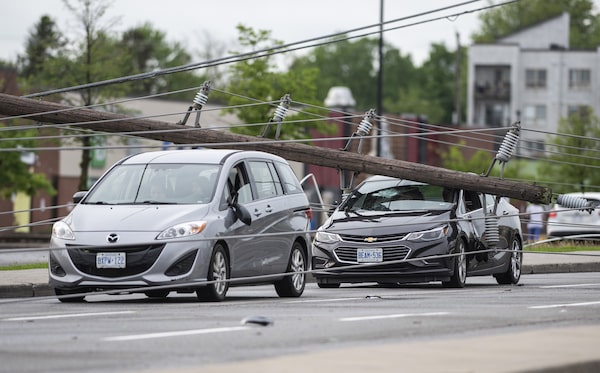
Canadians had to contend with extensive flooding in southern Manitoba as high water levels washed out Highway 307 and led to several hundred residents being evacuated in May.JOHN WOODS/The Canadian Press
Glenn McGillivray is the managing director of the Institute for Catastrophic Loss Reduction and an adjunct professor of disaster and emergency management at York University. Korey Pasch is a PhD candidate in the department of political studies at Queen’s University.
One of the major challenges presented by disasters is that, in quite short order, they begin to pile up. We aren’t able to work through the challenges presented by one and recover before we can move on to the next. Instead, response and recovery for several disasters overlap, often over the course of several months or even years.
This has been particularly evident in Canada in just the last while. In the last few weeks alone, Canadians have had to contend with both extensive flooding in southern Manitoba and a massive storm known as a derecho in Southern Ontario and Quebec, an event that’s expected to rank in the top 10 largest Canadian insured disaster losses of all time.
A utility worker near a transmission tower that was damaged in a major storm in Ottawa, on May 24.Justin Tang/The Canadian Press
Many homes hit by hail in the northeast of Calgary in June 2020 are still boarded up waiting for repair, as are homes in Barrie, Ont., that were hit by a powerful tornado in July, 2021. Widespread rebuilding of the village of Lytton, B. C., razed by wildfire in June 2021, has yet to begin and many residents of Abbotsford, Merritt, Sumas Prairie and other B.C. communities are still out of their homes as a result of the November 2021 atmospheric river event. The list goes on.
These days, there is no time to catch our breath as the impacts of disasters, fueled by climate change, continue to hit much of the country. And, it appears, no one is immune. While some years it seems that Alberta is ground zero for these events, over time, other provinces get a go at it, as B.C. did last year. This year, it appears to be Manitoba, Ontario and Quebec’s turn.
A big bet on geothermal could help prevent a climate catastrophe
B.C.’s unprecedented weather disasters require bold investment in watershed security
Yet, even in the face of this seemingly back to back to back to back chaos, as a society we still insist on treating these events as rarities, as unforeseeable shocks for which we have no uniform approach. We continue to go at them in ad hoc ways, like we re-set the system after each one.
It’s clear that we must change our thinking about “natural” disasters (”natural” is in quotes because there is no such thing as a natural disaster. While the peril is natural, whether we let it become a disaster is our choice). We must work to put into place better plans, processes and procedures before, during and in the aftermath of these events. This so that we can avoid disaster when possible, mitigate the impacts of events when we can’t entirely avoid them, recover more quickly and build back better so that we don’t go through it all again at some point in the future.
The ongoing flooding in Manitoba and the Ontario/Quebec derecho of last month are just the latest examples of why we must get better at managing catastrophic events in Canada.

It has become clear that we must change our thinking about 'natural' disasters.Justin Tang/The Canadian Press
To be sure, the mantra that there is no such thing as a “natural disaster” is not a question of semantics. Disasters are, in fact, purely optional. They come when a hazard intersects with societal vulnerability – or bad decision-making, as I heard one disaster researcher put it. Mother Nature may have caused the lightning-induced wildfire, but she didn’t place the (flammable) community in its way – we did.
So it is important that we understand that “natural” disasters are far from being out of our hands. Indeed, many factors exacerbate the impacts of natural hazards and virtually all are completely under our control.
And while some of these factors are more obvious, like building codes, land-use planning and other standards and policies that affect the built environment, others appear not to be connected to disasters, at least at first glance. These include addressing poverty and the housing crisis so that individuals, families and the broader community are less vulnerable to severe storms like the derecho.
Changing our thinking will assist in shifting how we approach the aftermath of catastrophic events as well. We need to move from reproducing the status quo and shrugging our collective shoulders – accepting the derecho and other “natural” disasters as simply Mother Nature’s wrath – to understanding that the outcomes of these events are by our own design.
If we want to reduce the impacts of the next catastrophic event (which, recent history tells us, isn’t that far off) we must shift our thinking and take the steps necessary to better prepare for and manage catastrophic events.
Understanding that “natural” disasters aren’t natural is the first step in limiting the damage of the inevitable next event.
Keep your Opinions sharp and informed. Get the Opinion newsletter. Sign up today.